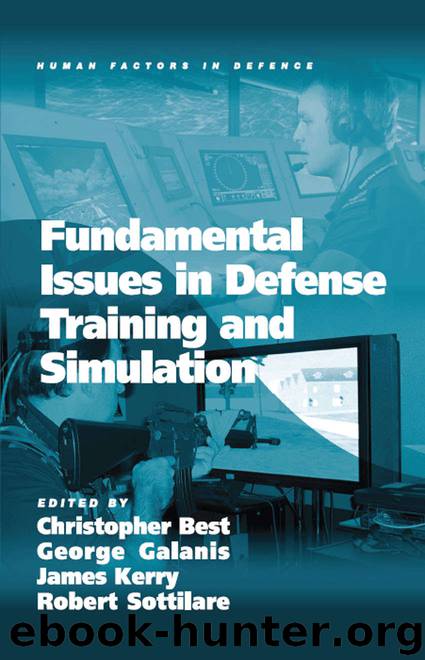Fundamental Issues in Defense Training and Simulation (Human Factors in Defence) by George Galanis & Robert Sottilare

Author:George Galanis & Robert Sottilare [Galanis, George]
Language: eng
Format: azw3
Publisher: CRC Press
Published: 2017-05-15T04:00:00+00:00
Benefits of VE Training
When designed to ensure appropriate levels of functional, physical, and psychological fidelity based on targeted training goals, VEs can provide the means to present realistic experiences (i.e., represent perceptual cues, engender task immersion and presence) to individuals while maintaining a relatively safe environment (Stanney, Costello, & Kennedy, 2007). Such training systems can allow for the presentation of conditions and situations that would otherwise be too risky or costly (e.g., exposure to imminent threats during patrols; brigade-level exercises) to attempt in real life, thus allowing individuals to experience and acclimate to such challenges. VEs can offer (1) interactivity – the ability to actively control user interaction in real time as opposed to being a passive bystander; (2) egocentric perspective – where the trainee can be immersed within the surrounding environment and experience a first-person perspective; and (3) spatial and temporal continuums – the provision of an environmental surround that dynamically changes over time. Thus, trainees are able to act upon and respond to environmental changes and experience the direct and indirect impacts of their responses within VE training, thereby enhancing procedural knowledge of operations. Further, this experience allows trainees to anticipate both expected and unexpected events, offering the opportunity to explore alternative actions and develop a repertoire of behaviors or multiple solutions/consequences in a relatively safe environment. This action/consequence practice can lead to the development of strategic knowledge, as well as problem solving and planning skills.
Beyond allowing trainees to perform in realistic situations similar to operational performance, VEs have the added benefits of repeatability and adaptation. Specifically, VEs allow for the rapid replication of conditions or adjustment of these conditions as necessary to accommodate the needs of individual trainees (e.g., learning progress, remediation) or to provide the variability necessary to generate new training experiences. Within live training, this personalized training opportunity becomes challenging, as exercises involve teams of teams and thus repeating exercises to address individual inefficiencies is not cost effective. However, similar teams-of-teams scenarios can be readily repeated within a VE, as adversaries and blue forces are synthetic agents who can readily be “reset” to provide individualized (precision) training in a cost-effective and safe environment. Further, VEs can support distributed training through networked systems, saving on travel and logistics costs associated with bringing multiple trainees to a consolidated training facility that must be maintained. Having distributed training systems allows for team training events, providing precision training at a team level – optimizing team interactions and backup behaviors critical for effective operations.
Training benefits can also be maximized by leveraging the unique capabilities of VEs and associated performance assessment tools to capture and very quickly analyze performance data to facilitate debrief. Oftentimes live training debriefs focus on outcome measures, such as mission success, due to limitations in data collection (e.g., monitoring and/or remembering the complexities of performance over an entire mission). However, process measures provide a more granular level of assessment, which facilitates monitoring of the root causes that contributed to outcome performance issues (Eddy, 1998). Current technology provides
Download
This site does not store any files on its server. We only index and link to content provided by other sites. Please contact the content providers to delete copyright contents if any and email us, we'll remove relevant links or contents immediately.
| Automotive | Engineering |
| Transportation |
Whiskies Galore by Ian Buxton(41712)
Introduction to Aircraft Design (Cambridge Aerospace Series) by John P. Fielding(33011)
Small Unmanned Fixed-wing Aircraft Design by Andrew J. Keane Andras Sobester James P. Scanlan & András Sóbester & James P. Scanlan(32678)
Craft Beer for the Homebrewer by Michael Agnew(18076)
Turbulence by E. J. Noyes(7888)
The Complete Stick Figure Physics Tutorials by Allen Sarah(7258)
Kaplan MCAT General Chemistry Review by Kaplan(6813)
The Thirst by Nesbo Jo(6748)
Bad Blood by John Carreyrou(6468)
Modelling of Convective Heat and Mass Transfer in Rotating Flows by Igor V. Shevchuk(6349)
Learning SQL by Alan Beaulieu(6152)
Weapons of Math Destruction by Cathy O'Neil(6077)
Man-made Catastrophes and Risk Information Concealment by Dmitry Chernov & Didier Sornette(5870)
Digital Minimalism by Cal Newport;(5576)
Life 3.0: Being Human in the Age of Artificial Intelligence by Tegmark Max(5398)
iGen by Jean M. Twenge(5295)
Secrets of Antigravity Propulsion: Tesla, UFOs, and Classified Aerospace Technology by Ph.D. Paul A. Laviolette(5232)
Design of Trajectory Optimization Approach for Space Maneuver Vehicle Skip Entry Problems by Runqi Chai & Al Savvaris & Antonios Tsourdos & Senchun Chai(4949)
Electronic Devices & Circuits by Jacob Millman & Christos C. Halkias(4859)
